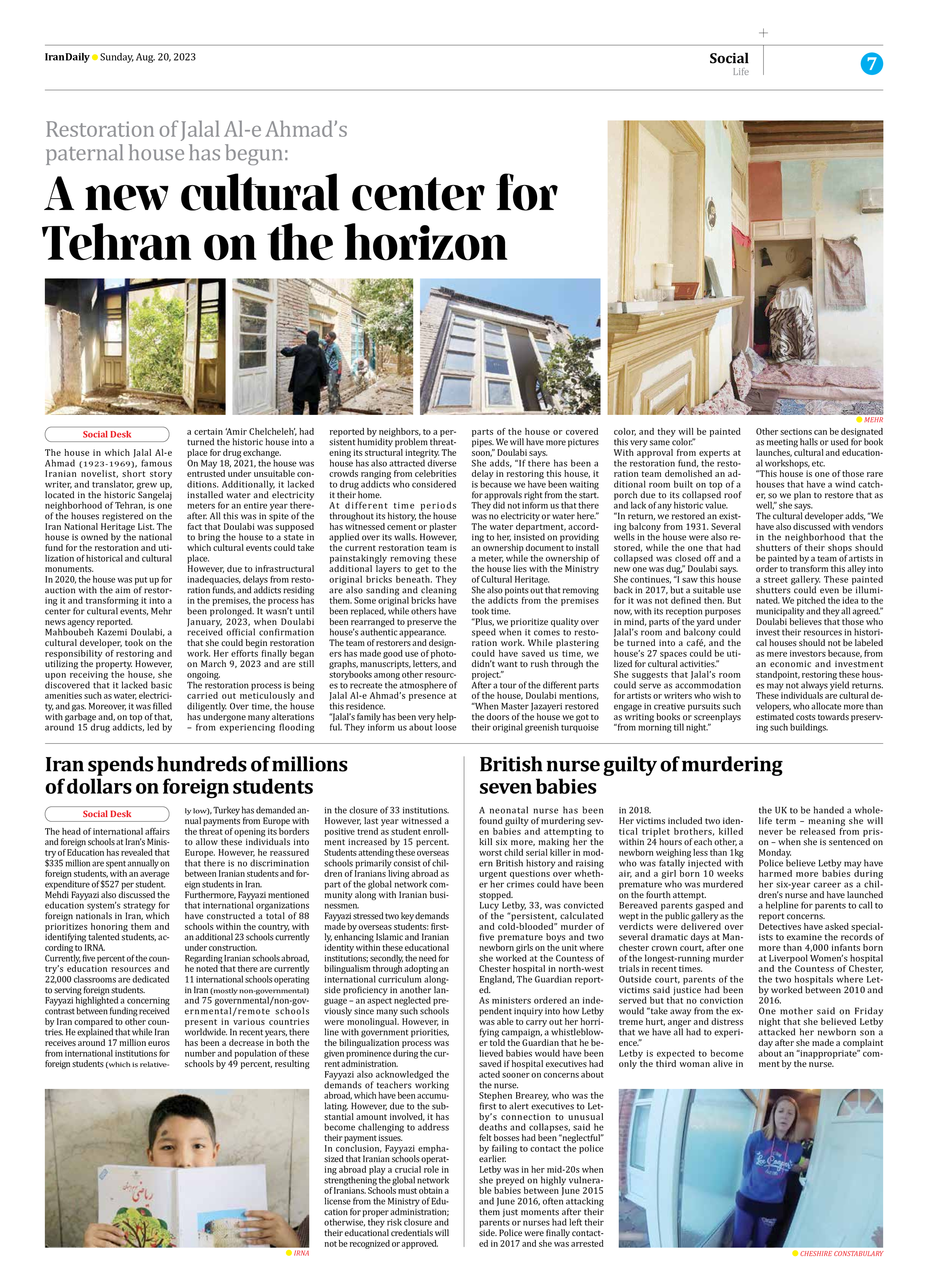
Restoration of Jalal Al-e Ahmad’s paternal house has begun:
A new cultural center for Tehran on the horizon
The house in which Jalal Al-e Ahmad (1923-1969), famous Iranian novelist, short story writer, and translator, grew up, located in the historic Sangelaj neighborhood of Tehran, is one of the houses registered on the Iran National Heritage List. The house is owned by the national fund for the restoration and utilization of historical and cultural monuments.
In 2020, the house was put up for auction with the aim of restoring it and transforming it into a center for cultural events, Mehr news agency reported.
Mahboubeh Kazemi Doulabi, a cultural developer, took on the responsibility of restoring and utilizing the property. However, upon receiving the house, she discovered that it lacked basic amenities such as water, electricity, and gas. Moreover, it was filled with garbage and, on top of that, around 15 drug addicts, led by a certain ‘Amir Chelcheleh’, had turned the historic house into a place for drug exchange.
On May 18, 2021, the house was entrusted under unsuitable conditions. Additionally, it lacked installed water and electricity meters for an entire year thereafter. All this was in spite of the fact that Doulabi was supposed to bring the house to a state in which cultural events could take place.
However, due to infrastructural inadequacies, delays from restoration funds, and addicts residing in the premises, the process has been prolonged. It wasn’t until January, 2023, when Doulabi received official confirmation that she could begin restoration work. Her efforts finally began on March 9, 2023 and are still ongoing.
The restoration process is being carried out meticulously and diligently. Over time, the house has undergone many alterations – from experiencing flooding reported by neighbors, to a persistent humidity problem threatening its structural integrity. The house has also attracted diverse crowds ranging from celebrities to drug addicts who considered it their home.
At different time periods throughout its history, the house has witnessed cement or plaster applied over its walls. However, the current restoration team is painstakingly removing these additional layers to get to the original bricks beneath. They are also sanding and cleaning them. Some original bricks have been replaced, while others have been rearranged to preserve the house’s authentic appearance.
The team of restorers and designers has made good use of photographs, manuscripts, letters, and storybooks among other resources to recreate the atmosphere of Jalal Al-e Ahmad’s presence at this residence.
“Jalal’s family has been very helpful. They inform us about loose parts of the house or covered pipes. We will have more pictures soon,” Doulabi says.
She adds, “If there has been a delay in restoring this house, it is because we have been waiting for approvals right from the start. They did not inform us that there was no electricity or water here.”
The water department, according to her, insisted on providing an ownership document to install a meter, while the ownership of the house lies with the Ministry of Cultural Heritage.
She also points out that removing the addicts from the premises took time.
“Plus, we prioritize quality over speed when it comes to restoration work. While plastering could have saved us time, we didn’t want to rush through the project.”
After a tour of the different parts of the house, Doulabi mentions, “When Master Jazayeri restored the doors of the house we got to their original greenish turquoise color, and they will be painted this very same color.”
With approval from experts at the restoration fund, the restoration team demolished an additional room built on top of a porch due to its collapsed roof and lack of any historic value.
“In return, we restored an existing balcony from 1931. Several wells in the house were also restored, while the one that had collapsed was closed off and a new one was dug,” Doulabi says.
She continues, “I saw this house back in 2017, but a suitable use for it was not defined then. But now, with its reception purposes in mind, parts of the yard under Jalal’s room and balcony could be turned into a café, and the house’s 27 spaces could be utilized for cultural activities.”
She suggests that Jalal’s room could serve as accommodation for artists or writers who wish to engage in creative pursuits such as writing books or screenplays “from morning till night.”
Other sections can be designated as meeting halls or used for book launches, cultural and educational workshops, etc.
“This house is one of those rare houses that have a wind catcher, so we plan to restore that as well,” she says.
The cultural developer adds, “We have also discussed with vendors in the neighborhood that the shutters of their shops should be painted by a team of artists in order to transform this alley into a street gallery. These painted shutters could even be illuminated. We pitched the idea to the municipality and they all agreed.”
Doulabi believes that those who invest their resources in historical houses should not be labeled as mere investors because, from an economic and investment standpoint, restoring these houses may not always yield returns. These individuals are cultural developers, who allocate more than estimated costs towards preserving such buildings.







